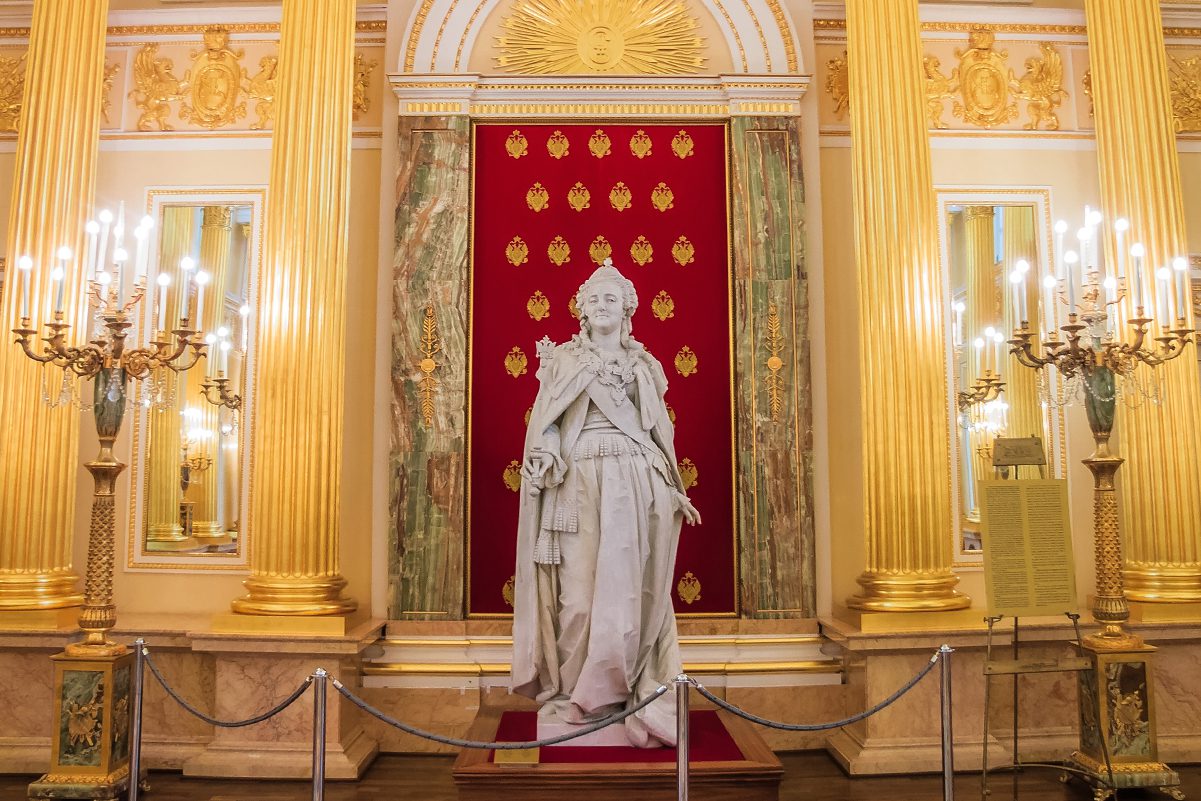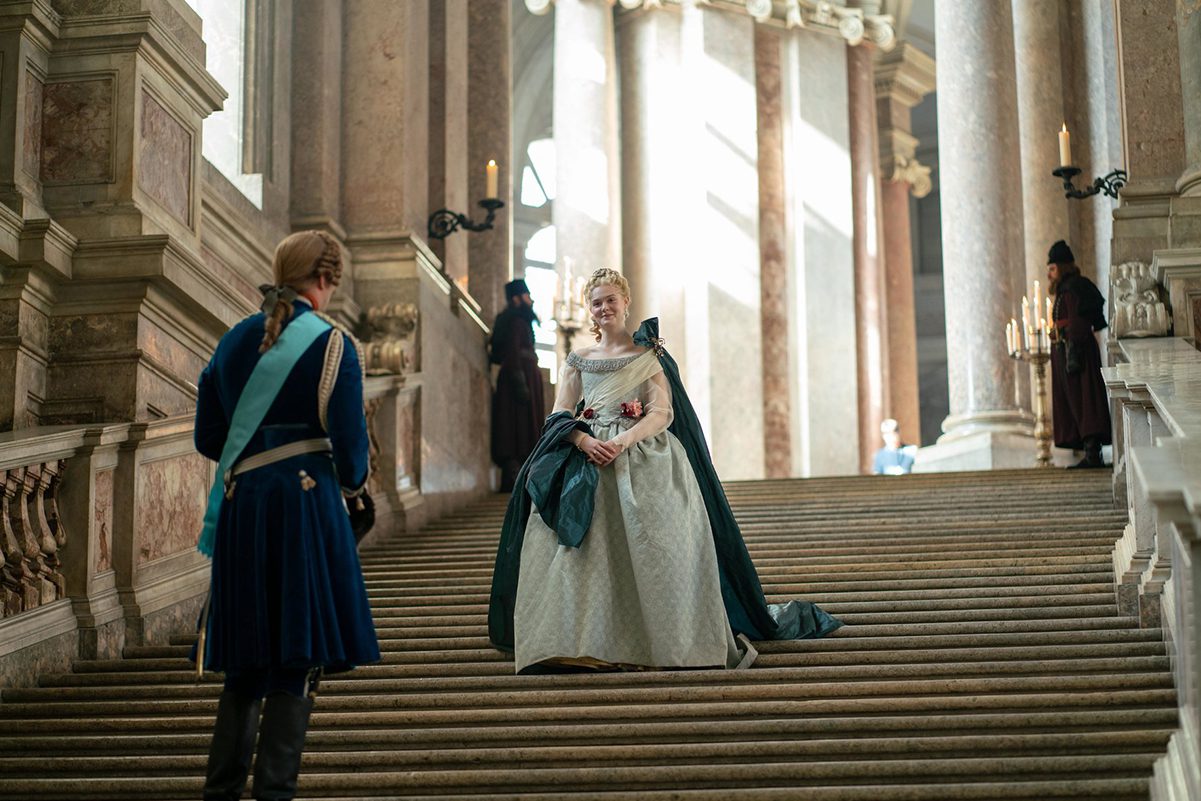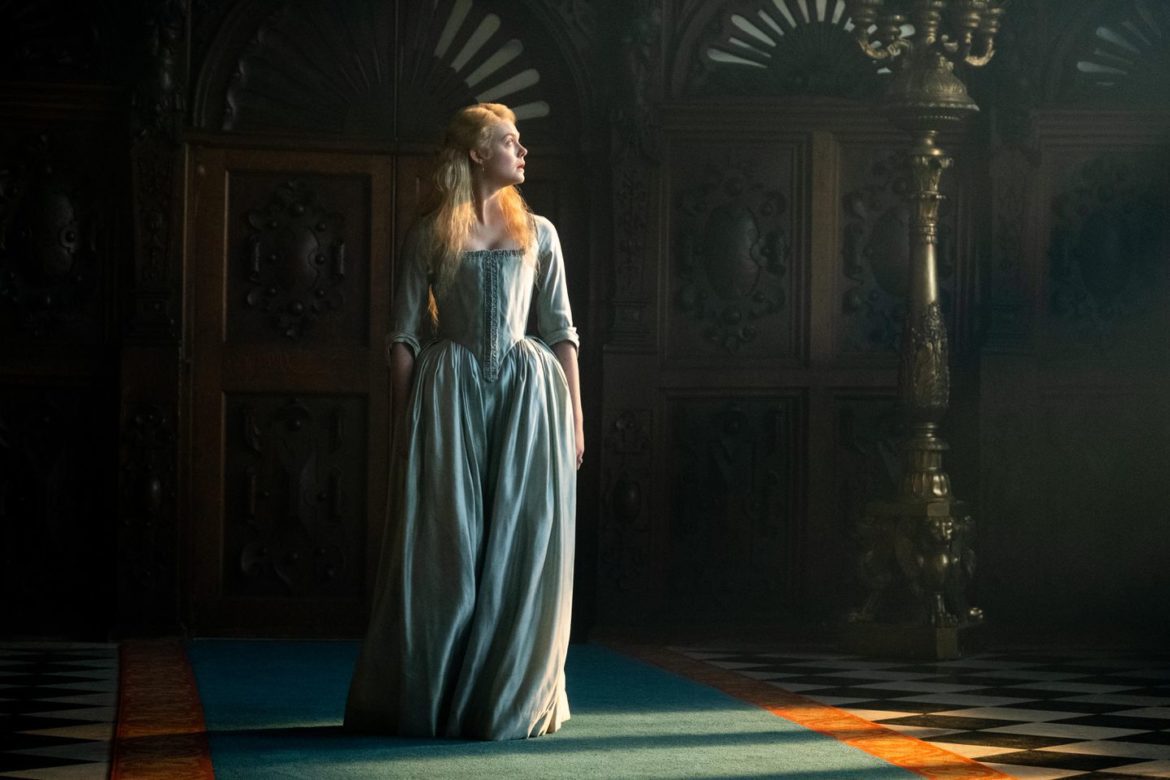CATHERINE THE GREAT (1729-1796) ushered the European Age of Enlightenment in Russia after she deposed her husband, Emperor Peter III and took over power as the longest-ruling female leader in the history of Russia. A voracious reader with a ravenous mind for learning, she was entirely self-taught to become the most educated women of her day. Politically savvy, extremely intelligent, she expanded Russia’s boundaries, built towns and cities, extraordinary palaces, amassed the world’s greatest art collections, and advocated education, even among the masses.
Born Princess Sophie Friederike Auguste von Anhalt-Zerbst-Dornburg in the kingdom then known as Prussia, she assumed the name Catherine after she was betrothed to Peter, her second cousin, when she was only ten. She found him childish (he spent hours playing with his toy soldiers) and loathsome (he was a drunk and philanderer), and when his aunt, Empress Elizabeth, died he assumed the throne. Catherine endeared herself to the Russian Court, converted to Russian Orthodoxy, learned to speak Russian perfectly, and adopted the lavish, extravagant life of the French Court of Louis XIV at Versailles—replete with political intrigue, conspiracies, scandals, and sexual indulgences.

Catherine loathed being alone and kept a steady stream of lovers—as many as 22—but she prided herself in being a monogamist, taking one lover at a time, sometimes two, all but one of whom were younger than she. She preferred a man in uniform of noble birth, a charmer with a sense of humor, who could keep up with her spirited conversation.
Her first lover was Count Sergei Saltykov, the only one who was older than she (he was 26, she was 23.) Their affair began in 1752, when Catherine was married to Peter, but it was relatively brief. After being elevated with a more noble title and given other “gifts,” he left court. Catherine hinted in her memoirs that Saltykov was the father of her firstborn child, Paul Romanov, heir to the throne, but Paul’s resemblance to Peter III was so keen that it was presumed he was his father.
Stanislaw Poniatowski, a young Polish count, was next. Cultured and multilingual, he was the 23-year-old secretary to the British ambassador to Russia when he met Catherine, then 26. “My whole life was devoted to her,” wrote the romantic. Things became rather reckless as Catherine still was married to Peter and scandal ensued, ending with Stanislaw’s banishment back home to Catherine loathed being alone and kept a steady stream of lovers—as many as 22—but she prided herself in being a monogamist, taking one lover at a time, sometimes two, all but one of whom were younger than she. She preferred a man in uniform of noble birth, a charmer with a sense of humor, who could keep up with her spirited conversation.
Her first lover was Count Sergei Saltykov, the only one who was older than she (he was 26, she was 23.) Their affair began in 1752, when Catherine was married to Peter, but it was relatively brief. After being elevated with a more noble title and given other “gifts,” he left court. Catherine hinted in her memoirs that Saltykov was the father of her firstborn child, Paul Romanov, heir to the throne, but Paul’s resemblance to Peter III was so keen that it was presumed he was his father.
Stanislaw Poniatowski, a young Polish count, was next. Cultured and multilingual, he was the 23-year-old secretary to the British ambassador to Russia when he met Catherine, then 26. “My whole life was devoted to her,” wrote the romantic. Things became rather reckless as Catherine still was married to Peter and scandal ensued, ending with Stanislaw’s banishment back home to Poland, where he eventually was crowned king. That, though, was part of Catherine’s greater plan. She partitioned Poland to Russia, gaining enormous territory, and Stanislaw was deprived of possessions and power. According to Catherine’s memoirs, Stanislaw was father to Catherine’s second daughter, Anna, who died at 15 months. Afterward, she would suffer two miscarriages before giving birth to her son, Paul; then followed Alexei, the son of Orlov, who lived to be 51 and last, Elizabeth, professed illegitimate daughter by Potemkin. Elizabeth died in 1854, age 78.
Next was Grigory Orlov, Catherine’s junior by five years. Their affair lasted 12 years. When Peter became tsar in 1762, Grigory helped Catherine depose her husband so she could assume the throne. Eight days after he was exiled to his palace in Ropsha, Peter III was found dead. It is generally held that Grigory’s younger brother, Aleksey Orlov, arranged the dethroned tsar’s assassination. Not surprisingly, both brothers received titles, wealth, and property—Catherine had the Marble Palace built for Grigory as a small token of her appreciation. She had given birth to Grigory’s son, Aleksey, in 1762 in the midst of all this intrigue. Her pregnancy had been hidden and the newborn was whisked away the moment he let out his first cry. Raised by his father, she did not set eyes on her son again until he was 19-years-old. Shortly after Aleksey was born, Catherine learned that Grigory had amassed a small harem of mistresses. He was banished from court forevermore and Catherine engaged in a brief rebound affair with Alexander Vasilchickov, who she dismissed with a pension of 20,000 rubles ($2 million in today’s money.)
It was then that she met the love of her life, Grigory Potemkin. He was everything she ever wanted in a lover—charming, engagingly sociable and an eloquent conversationalist, a man she considered her equal and whom she would call “my twin soul.” They conducted an open relationship for 17 years and it is believed they entered into a morganatic marriage. Potemkin was extremely powerful and was to Catherine what Prince Albert became to his wife, Queen Victoria of England, a century later. Catherine and Potemkin, in essence, co-ruled Russia. She had him crowned Prince of the Holy Roman Empire and gave him rule over Russia’s southern provinces. As a result, he was absent for long periods. After one such absence, Potemkin returned to Catherine in St. Petersburg only to discover her in the embrace of another man, Platon Zubov. Inexplicably, Potemkin failed to regain her affections, fell ill on his return to the provinces, and died. Devasted to have lost the only man in her life she had, or ever would, truly rely upon, she cried relentlessly for many weeks.
While this is not a diatribe on the loves of Catherine the Great, it would be remiss not to mention her last lover. He was the vain, ambitious, meddling, arrogant, air-head Platon Zubov—the very man Potemkin found in Catherine’s bed. Her junior by 33 years, Catherine showered him with titles, estates, and riches, and he took advantage of his position to force the court to defer to him and mistreat Catherine’s son, Prince Paul, heir to the throne. When she died and Paul became tzar, he immediately stripped Platon of all his mother had given him. Holding a bitter grudge, Platon was part of the conspiracy that brutally murdered Emperor Paul in cold blood just five years later.
Live and love like an empress? Perhaps not. But there is a lesson to be learned. In her lifetime, she did enormous good despite the bad. She left her beloved adopted country a far better place than the day she first set foot on Russian soil, at the age of 16, when she knelt and kissed the sun-warmed earth. Catherine the Great was indeed great. Catherine the Great was one of the original Inspiring Women.
Catherine the Great has been the subject of countless films and many miniseries, The Great being the most recent. What was it about this naive, unblemished young woman who came to the Russian Court to marry–only to evolve into one of the most powerful, intelligent, ruthless, visionary rulers in history, and whose lust for power was purportedly as intense as her lust for sex?
We’ll know more as Season 2 of HULU streaming series, The Great, debuts this week.
The Great

The binge-worthy, 10-part, historical dramatic comedy series streaming on HULU
The Great, starring Elle Fanning as Catherine the Great (1729-1796), the last reigning empress of Russia and Nicholas Hoult as her frivolous, ill-fated husband, Emperor Peter III, is broadly inspired by their lives and events in Russia in the last half of the 18th century and clearly described by its producers as “anti-historical”—or is it? Who can say? But the framework upon which this spectacular show is built is solidly based on history as we know it.
The young, naïve, and hopeful Prussian Princess Sophie Friederike Auguste von Anhalt-Zerbst-Dornburg, called Catherine, arrives in Russia, age 15, to wed the heir to the Russian throne, to whom she was betrothed at the age of 10 in a carefully arranged political marriage. In the series, she is ostracized at a court whose intrigues—political and sexual—are even more sensational than similar doings at Versailles. Catherine’s innocence is soon shattered as the intelligent, intrinsically clever and somewhat devious young woman comes to terms with her circumstances—and sets out to conquer and rule over one and all.
This binge-watchable, ten-part American comedic drama, which streams on HULU, was, deservedly, nominated for 26 combined Primetime Emmy Awards, Screen Actors Guild Awards, Golden Globes, among others and won eight. The cast is amazing, the filming and scenes extraordinary, and the good news is we don’t have to wait much longer. Season 2 and another 10 enthrallingly juice episodes is scheduled for November 19. Huzzah!


